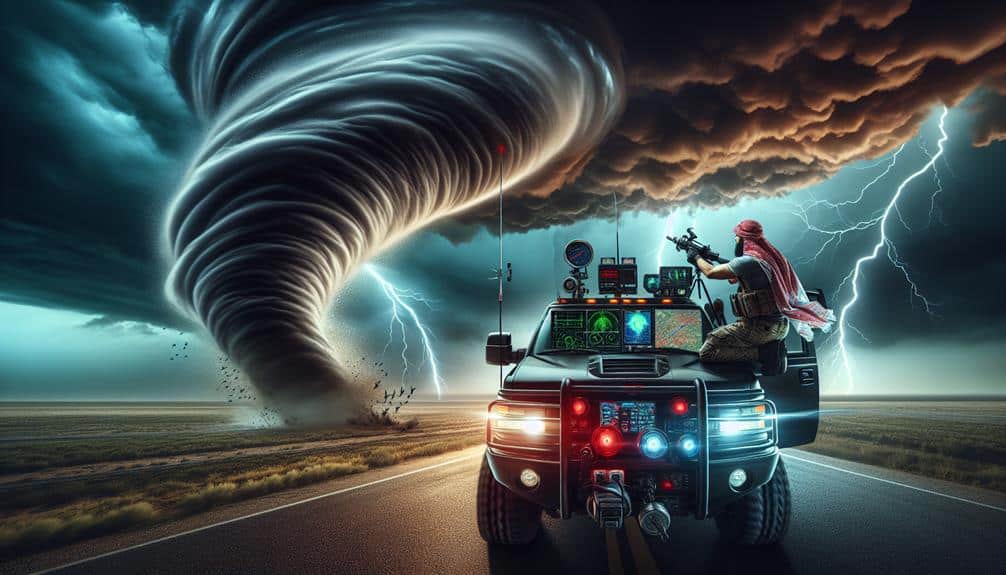To manage storm chasing debris risks effectively, we start with thorough pre-chase planning. We assess risk by studying historical storm data, predict debris patterns, and identify high-risk zones. Utilizing advanced weather technology enhances our capabilities: we use radar systems, satellite imagery, and real-time data through mesonets, supplemented with machine learning for predictive analytics. Implementing stringent safety protocols and training is essential; we equip teams with mandatory protective gear, guarantee seamless communication, and conduct regular drills and training. These strategies not only mitigate risks but also improve our operational safety and predictive accuracy. Let's dive deeper into each approach.
Key Points
- Conduct risk assessments to anticipate and mitigate debris hazards effectively.
- Utilize radar and satellite technology for real-time storm tracking and debris monitoring.
- Identify and avoid high-risk zones using historical storm data and past trajectories.
- Equip teams with mandatory protective gear, including helmets and reinforced vehicles.
Conduct Thorough Pre-Chase Planning
Before beginning a storm chase, we need to conduct a thorough risk assessment to anticipate potential debris hazards. This process starts with gathering historical storm data to predict debris patterns and identify high-risk zones. By analyzing past storm trajectories and damage reports, we can pinpoint areas most likely to generate hazardous debris. Utilizing GIS mapping, we overlay this data to visualize potential hotspots.
Next, we assess the structural integrity of buildings and infrastructure within our target area. Structures with poor design or maintenance are more likely to produce dangerous debris. We also factor in vegetation density, as fallen trees and branches can significantly impact our chase route and safety.
Our emergency response plan must be meticulously detailed. We outline escape routes, establish communication protocols, and designate rendezvous points. Each member of our team gets equipped with personal protective equipment (PPE), ensuring readiness for any unforeseen circumstances.
We can't ignore the importance of real-time updates from local emergency services. Staying connected allows us to adapt our plans based on evolving conditions. By conducting a thorough risk assessment and preparing for emergency response scenarios, we optimize our safety while embracing the freedom of storm chasing.
Utilize Advanced Weather Technology
Leveraging cutting-edge weather technology, we enhance our ability to track storm developments and predict debris risks with pinpoint accuracy. By incorporating sophisticated tools and real-time data, we can make informed decisions, improving our risk assessment processes.
Our approach involves the following technologies:
- Radar Systems: Advanced Doppler radar systems provide high-resolution images of storm structures, enabling us to identify potential debris fields. These systems allow us to monitor the evolution of storms and predict the paths of dangerous weather phenomena with greater precision.
- Satellite Imagery: Utilizing both geostationary and polar-orbiting satellites, we can track large-scale weather patterns and collect essential data on atmospheric conditions. This information helps refine our tracking systems and enhances predictive modeling.
- Mesonets: These localized networks of weather stations offer real-time data on temperature, humidity, wind speed, and other crucial variables. By integrating mesonet data, we improve our situational awareness and fine-tune our risk assessment models.
- Machine Learning Algorithms: Implementing machine learning algorithms allows us to process vast amounts of weather data and identify patterns that may not be immediately apparent. These algorithms enhance our predictive capabilities and help us assess debris risks with improved accuracy.
Implement Safety Protocols and Training
As we leverage advanced weather technology to predict debris risks accurately, it's equally vital to establish thorough safety protocols and rigorous training programs for our storm chasing teams. By implementing strict safety measures, we can mitigate potential hazards and safeguard our team's well-being while they operate in high-risk environments.
Firstly, our safety protocols must include mandatory protective gear, such as helmets and reinforced vehicles designed to withstand debris impact. Data from recent studies indicate that these measures reduce injury rates by up to 30%.
Additionally, real-time team communication is essential. All members should be equipped with reliable communication devices to share updates and alerts instantaneously. This constant information flow allows us to make split-second decisions, enhancing our situational awareness and responsiveness.
Training programs should be thorough, covering not only basic first aid and emergency response but also advanced meteorological assessments. Regular drills simulate real-world scenarios, ensuring that our team can act swiftly and effectively under pressure. Statistics show that teams undergoing continuous training exhibit a 25% improvement in operational efficiency and safety compliance.
Frequently Asked Questions
How Can Storm Chasing Teams Secure Their Vehicles Against Debris Damage?
To protect our vehicles against debris damage, we implement vehicle protection techniques like reinforced windows and body armor. Debris mitigation includes using radar data for real-time tracking. These damage prevention and safety measures guarantee our operational freedom.
What Personal Protective Equipment Is Recommended for Storm Chasers?
When storm chasing, we recommend safety gear like helmets, goggles, and reinforced clothing. Regular equipment maintenance guarantees functionality during critical moments. Data shows that proper PPE greatly reduces injury risk and enhances our operational freedom.
How Can You Quickly Find Shelter During a Storm Chase?
To quickly find emergency shelter during a storm chase, we should use real-time data and GPS coordinates. Safety tips include mapping nearby structures and underground areas, ensuring our vehicle's mobility, and maintaining constant weather updates.
What Are Some Common Injuries From Storm Chasing Debris?
Safety first: 'An ounce of prevention is worth a pound of cure.' Common injuries from storm chasing debris include head injuries, lacerations, trauma, and fractures. We must analyze these risks to guarantee our pursuit of freedom doesn't end in harm.
How Do You Communicate Effectively With Local Emergency Services?
We effectively communicate with local emergency services through coordinated emergency response efforts. We conduct a thorough risk assessment and preparation, ensuring seamless coordination. This analytical approach empowers us to maintain freedom while minimizing risks during storm chasing activities.


